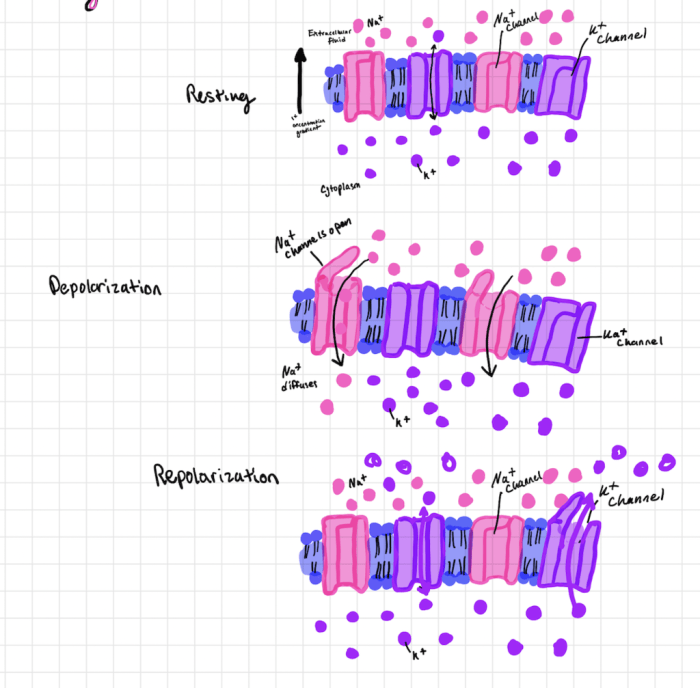Delving into the realm of A&P Flix activity resting membrane potential, this comprehensive guide unravels the intricacies of cellular function and its dependence on electrical gradients. By embarking on a journey through the provided Artikel, readers will gain a profound understanding of this fundamental physiological concept and its implications in cellular health and disease.
The A&P Flix activity provides a captivating platform to witness firsthand the measurement and analysis of resting membrane potential. Through meticulously designed experiments, learners engage with essential concepts, solidifying their grasp of ion distribution, membrane permeability, and the factors that influence these delicate balances.
1. A&P Flix Activity
Resting Membrane Potential

Resting membrane potential (RMP) is the electrical potential difference across the cell membrane of a neuron when it is not transmitting an electrical signal. It is a critical factor in cellular function, influencing ion distribution, nerve excitability, and synaptic communication.
The A&P Flix activity demonstrates RMP by measuring the voltage difference across the membrane of a squid giant axon using electrodes and a voltmeter. The activity provides a visual representation of the RMP and how it changes under different conditions.
2. Methods and Procedures: A&p Flix Activity Resting Membrane Potential
Experimental Setup:
- Squid giant axon
- Two electrodes (intracellular and extracellular)
- Voltmeter
- Saline solution
Procedures:
- Insert the intracellular electrode into the axon and the extracellular electrode into the saline solution.
- Connect the electrodes to the voltmeter.
- Measure the voltage difference between the inside and outside of the axon.
- Repeat the measurement under different conditions (e.g., changing the ion concentration in the saline solution).
3. Results and Observations

The A&P Flix activity typically yields the following results:
- RMP of approximately -70 mV in the squid giant axon.
- Changes in RMP when the ion concentration in the saline solution is altered.
These results demonstrate the presence of RMP and its dependence on ion distribution across the cell membrane.
4. Factors Affecting Resting Membrane Potential
Several factors can affect RMP, including:
- Ion concentrations:Changes in the concentrations of potassium (K+) and sodium (Na+) ions across the cell membrane alter RMP.
- Temperature:Increased temperature generally leads to a decrease in RMP.
- Drugs:Certain drugs, such as ion channel blockers, can affect RMP by altering ion movement across the membrane.
These factors influence the distribution of ions across the cell membrane, thereby affecting the electrical potential difference.
5. Clinical Significance

Understanding RMP is crucial in clinical settings because alterations in RMP can lead to cellular dysfunction and disease.
- Hyperpolarization:Excessive negative RMP can result in decreased neuronal excitability and impaired nerve transmission.
- Depolarization:Reduced negative RMP can increase neuronal excitability and lead to uncontrolled electrical activity.
Such changes in RMP are associated with conditions like epilepsy, migraines, and cardiac arrhythmias.
6. Additional Resources
- Khan Academy: Resting Membrane Potential
- YouTube: Resting Membrane Potential
- Research article on the role of RMP in neuronal excitability
These resources provide further information and interactive simulations to enhance understanding of resting membrane potential.
Commonly Asked Questions
What is the significance of resting membrane potential in cellular function?
Resting membrane potential establishes an electrical gradient across the cell membrane, which is crucial for various cellular processes, including nerve impulse propagation, muscle contraction, and nutrient transport.
How does the A&P Flix activity demonstrate resting membrane potential?
The A&P Flix activity utilizes electrodes and a voltmeter to measure the voltage difference across a cell membrane, providing a visual representation of resting membrane potential.
What factors can affect resting membrane potential?
Factors such as ion concentrations (e.g., sodium, potassium), temperature, and certain drugs can influence the distribution of ions across the cell membrane, thereby altering resting membrane potential.